Cite this document
(Diets Affecting Human Behavior Research Paper Example | Topics and Well Written Essays - 1500 words, n.d.)
Diets Affecting Human Behavior Research Paper Example | Topics and Well Written Essays - 1500 words. https://studentshare.org/health-sciences-medicine/1868319-diets-affecting-human-behavior
Diets Affecting Human Behavior Research Paper Example | Topics and Well Written Essays - 1500 words. https://studentshare.org/health-sciences-medicine/1868319-diets-affecting-human-behavior
(Diets Affecting Human Behavior Research Paper Example | Topics and Well Written Essays - 1500 Words)
Diets Affecting Human Behavior Research Paper Example | Topics and Well Written Essays - 1500 Words. https://studentshare.org/health-sciences-medicine/1868319-diets-affecting-human-behavior.
Diets Affecting Human Behavior Research Paper Example | Topics and Well Written Essays - 1500 Words. https://studentshare.org/health-sciences-medicine/1868319-diets-affecting-human-behavior.
“Diets Affecting Human Behavior Research Paper Example | Topics and Well Written Essays - 1500 Words”. https://studentshare.org/health-sciences-medicine/1868319-diets-affecting-human-behavior.


